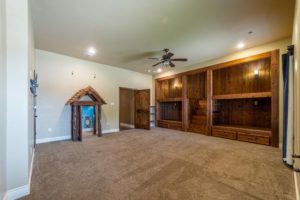
First off, start by referring to your city’s building department records. Many city and county records are now available online, which makes getting this info much easier than it used to be. Some updates – like unpermitted remodeling – may not be reflected in the records, but it will still provide a good baseline.
Then, familiarize yourself with basic ANSI guidelines for calculating square footage for single-family homes. Practices can vary slightly from market to market, but these rules apply to most areas in the country:
- Below grade spaces (basements, dens, etc.) do not usually count toward a home’s square footage. Even a finished basement can’t be counted toward a home’s Gross Living Area (GLA) but it can be noted separately in the listings total area.
- The ANSI method specifies measuring from the exterior of the house, but the wall width is not usually subtracted to account for actual living space.
- Stairways and closet areas are included in the square footage length.
- Finished attic square footage is included if an area has at least seven minimum feet of clearance.
- Covered, enclosed porches can only be included if they are heated using the same system as the rest of the house.
- Garages, pool houses, guest houses or any rooms that require you to leave the finished area of the main house to gain access are not counted.
- As a buyer, it can be helpful to know how to calculate square footage of a house yourself; just multiply the length and width of all applicable rooms in the home. All you’ll need to get started is a 100 sq ft tape measure, some graph paper, and a pencil.
How to calculate the square footage of your house
- Assign a unit of measureAssign a unit of measure to each square on the paper (a foot, for example) and measure to the nearest tenth of a foot.Pick a wallPick a wall and begin making your way around the interior perimeter of the house in one direction, drawing lines accordingly on the graph paper (though ANSI guidelines specify measuring the exterior walls, measuring from the inside will give you a better idea of the actual livable area).Look at your floor plan
Then, go back over your floor plan, multiply the rectangular areas, and add them all up to get your final number. If your calculation includes an area that is not permissible, don’t forget to subtract it out.
Note: Be aware that condominiums have fewer established rules and no ANSI guidelines. To start, you can visit your city’s building department and ask them to pull the home’s plans and permits for the property; the builders are required to include square footage for each unit. If that info is hard for you to get, you may want to hire an appraiser. If you’re a seller, it’s best to pay an appraiser to provide a square footage assessment so your listing is as accurate as possible. Finally, consult an agent. Agents usually see dozens of homes a week and have a pretty good spatial sense; they can often give you a ballpark estimate of any home in question.
Finally, remember that while square footage is important to your home value, don’t focus on it at the expense of style or your emotional response to it. Do you like the design and floorplan? How about the location? Are there rooms you absolutely love? Numbers are important, but they are no substitute for the intangibles that make a house feel like a home
- Assign a unit of measureAssign a unit of measure to each square on the paper (a foot, for example) and measure to the nearest tenth of a foot.Pick a wallPick a wall and begin making your way around the interior perimeter of the house in one direction, drawing lines accordingly on the graph paper (though ANSI guidelines specify measuring the exterior walls, measuring from the inside will give you a better idea of the actual livable area).Look at your floor plan








